Amplifiers have become the most necessary and fundamental items if you’re a musician, a DJ, or even if you own a pair of huge speakers. Since their inception, the amplifiers’ size has been decreasing; the complexity has been rising. To someone who will be buying their first amplifier, choosing the right one at the right price might seem like a daunting task. Here in this article, we will be discussing and reviewing some of the best 5000 watt amps. These 5000 watt amps are small and robust, making them highly useful.
We have chosen the most highly rated amplifiers, which will give you the best performance and highest bang for your buck. But before we jump into the review section, we have thought to provide you with a buyer’s guide to get to know the most important things you need to keep in mind while buying an amplifier.
Even if you are not new to the world of amplifiers, you should go through this buyer’s guide to get accustomed to more recent updates, technologies, and advances.
Table of Contents
- Buyer’s Guide – What to look for when buying 5000-watt amps
- List of the best 5000 watt amps
- Frequently Asked Questions
- Do all amplifiers fit into car audio systems?
- What are the amplifier classes?
- How to pair speakers with the amplifier?
- Do amplifiers improve bass performance?
- Do amplifiers improve sound quality?
- Is an amplifier necessary for a turntable?
- Is heating inadequate for the amplifier?
- How do amps cool down?
- Conclusion
- Related posts:
If you are interested in some powerful speakers, check our articles about tower speakers here: https://www.bestof.info/?s=tower+speakers.
Buyer’s Guide – What to look for when buying 5000-watt amps
Check for the amplifier’s wattage
Before buying an amplifier, the first thing you should consider is the wattage of the device. The wattage of your amplifier will depend upon how you will use the device.
For example, if you are buying the amplifier for folk music concerts at small venues, you need a maximum of 250 watts of power. On the other hand, if you’re planning for a full-on rock concert, you can up the ante to whatever you want up to 15000 watts.
Furthermore, always keep an eye on the RMS watts value. The RMS watt is the average watt of power that the amplifier can continuously output. This value provides a much realistic idea of how the performance of the device will be.
If you’re going to push the amplifier to its limit very often, you should also check out the Peek watt output value. It is the power output that the amplifier can deal with at any point in time. This peak output provides you with a bit of headroom, so that you can safely use your amplifier without the risk of damaging it.
You have nothing to worry about because there are many different amplifiers at different price ranges that can turn out the exact wattage you need.
Check the class of the amplifier
The classes of amplifiers define the ratio of their efficiency and their audio/sound fidelity. It’s a measure of how bulky an amplifier is. Many different classes of amplifiers exist; they start from A, B, AB, and extend up to class F and beyond.
Each class has its different characteristics but is simple terms, lower classes provide lower efficiency and sound quality, while higher classes provide higher effieciency sound quality. Class A amplifiers produce the highest quality sounds but are big, bulky, and inefficient.
On the contrary, class D amplifiers are the most famous amplifiers and are highly efficient, small, and lightweight and do not compromise sound fidelity. One of the significant disadvantages of lower classed amplifiers is that they produce too much heat.
This heat production is the leading cause of high input power and low output power of the amplifier. Old mechanisms make the class A amplifiers produce high heat, which compromises the amplifier’s life span. But class A amplifiers are also cost a lot and are hard to find because of their excellent sound quality.
Class D amplifiers are mass-produced and used by many people in many different circumstances, like small concerts and car audio systems.
Note down the amplifier modes
Amplifiers support different output modes that let you set up different types of speaker setups. If you have multiple speakers, you can have a stereo setup, a mono setup, or you can even scale up the power output as well.
There are mainly three different output modes for amplifiers. The first type being a stereo mode. You can attach two or more speakers to the amplifiers’ left and right channels in this mode. This mode will produce a distinct left and right stereo effect.
The second type of output is known as the parallel mode. In this mode, the amplifier sends the same product to all the speakers attacked to it. This mode is also known as a mono output. Usually, if you don’t need the stereo effect and want to reach the masses, this is the preferred output. For example, this is the best setup for speeches.
The third type is known as the bridge mode. In this mode, the amplifier lets you attach its stereo output to a single speaker and makes it act as a powerful mono output. Out need to be careful while using this mode because there are chances of it causing damage to the speakers.
It would help if you matched your amplifier and speaker power.
To properly match your amplifier’s powers with your speaker, you need to look at the amplifier’s RMS and your speaker’s program watts. Ideally, these two should be the same; when this happens, clipping and distortion do not take place.
But if your amplifier’s output power exceeds that of the speaker, then there are high chances your speaker might be operating beyond its safe limit. This circumstance might cause the speaker to sustain significant damages and even breakdown.
To monitor your speaker’s stress levels, you need to keep a check on the clipping or distortion indicators of your amplifier. If you see that the bars are glowing red more often, it is the indication of stress.
List of the best 5000 watt amps
1. TarampsBASS 5000 watt amps
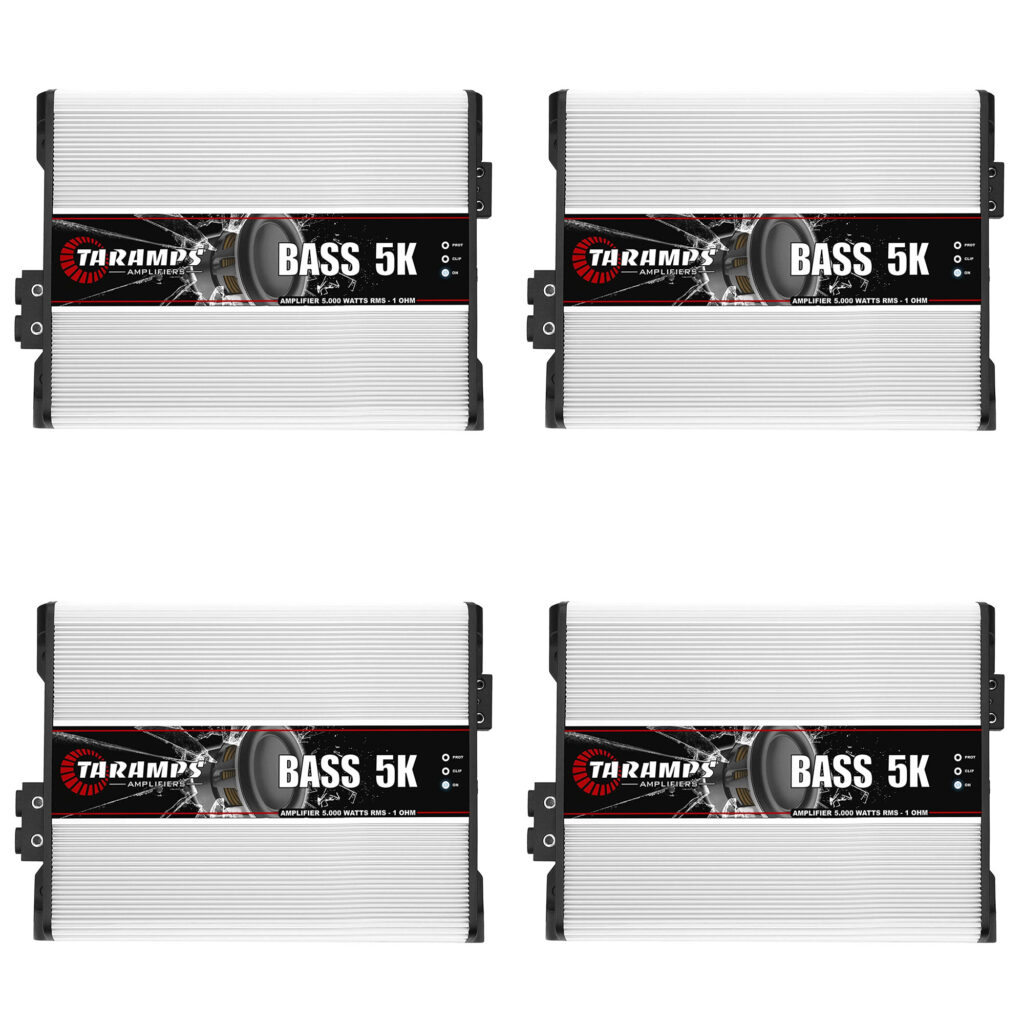

This cool looking class D amplifier can turn out a total output of 5000 watts from a single channel. The amplifier needs only 9 volts to run as it is operating at an 83% efficiency rate.
It has a sturdy build and weighs about 5kg. This weight makes it an ideal and powerful amplifier meant to be on the road and built to hustle at rock concerts.
Pros:
- It is lightweight, compact, and highly portable.
- The multi-protection system includes thermal, low voltage, short on output protection, and more.
- It has a low power consumption, therefore theoretically less costly to sustain.
- This amp model has a maximum rating of 17 VDC for power.
- It has a bass boost feature, which is equivalent to +/- 10 dB.
2. Stetsom Vulcan 5000 watt amp, 1 ohm, class D
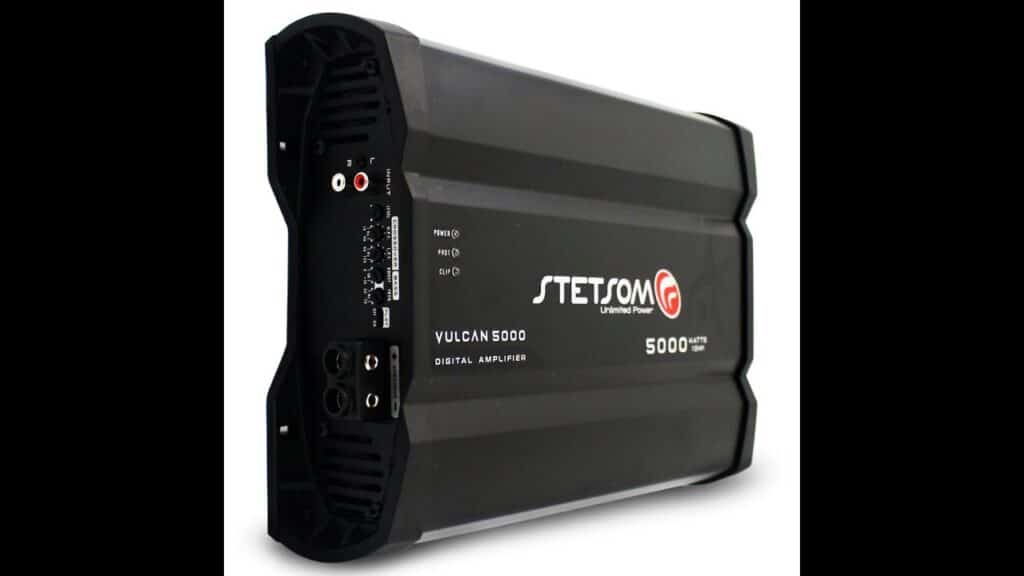

The design of the Stetsom Vulcan 5000 is sleek and gives out an aura of power. It uses proprietary technology to pump out a robust base and crisp, clear vocals.
It can operate at both 1 and 2 ohms providing both flexibility and decent power outputs. Furthermore, if you’re not a musician and buying it as a music lover, this can be one of the best amplifiers for your car audio setup as well.
Pros:
- It has a streamlined streak design, which helps it fit into unique car interior designs.
- The amplifier produces excellent vocal ranges and tones.
- It has an inbuilt bass boost feature, which produces excellent, rich, and loud bass.
- This amp produces constant RMS power of 5000 watts, 12.6V at 1 ohm.
- It has the lowest frequency response of 10Hz, making it highly sensitive.
3. Planet Audio AC5000.1D
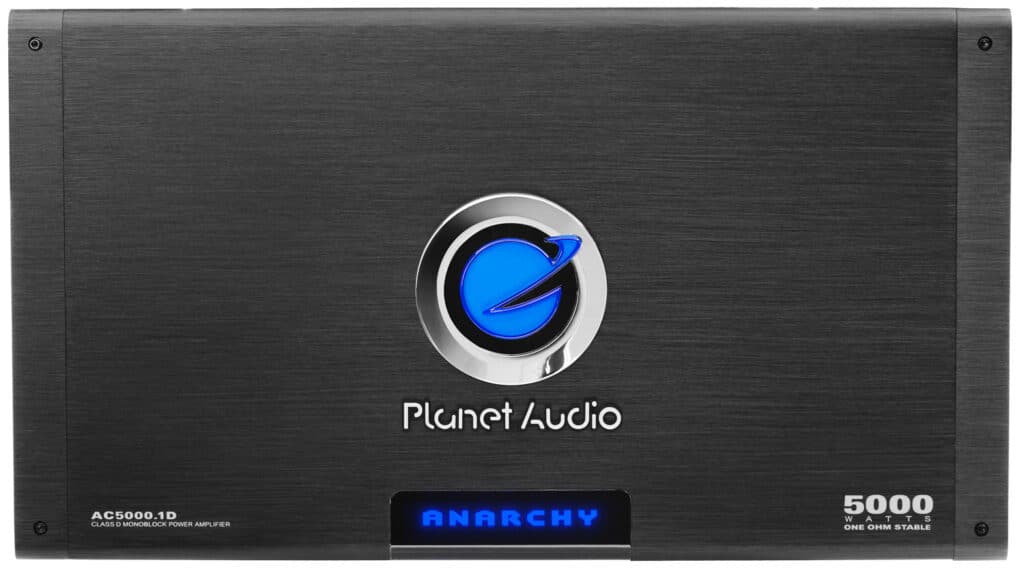

This amplifier from planet audio is easily one of the flashiest amplifiers on our list. It has futuristic looks and fantastic performance, thanks to the heat sink rib mechanism on the sides.
This amplifier provides lots of functionalities using different sound filters, a wired subwoofer control remote, and pairing mode for extra power and performance. At an input power of 12V, it’s not that power-hungry, and at under $250, it’s a fantastic bargain!
Pros:
- It has a lightweight, slim design making it favorable for small car spaces.
- This product integrates multiple sound filters like a subsonic filter, bass boost, and more.
- It has a glowing logo giving a lovely accent to its look.
- You can pair this with another AC5000.1D for a 10,000W amplifier system.
4. Taramp’s MD 5000.1 1 Ohm 5000 Watts Class D Amplifier
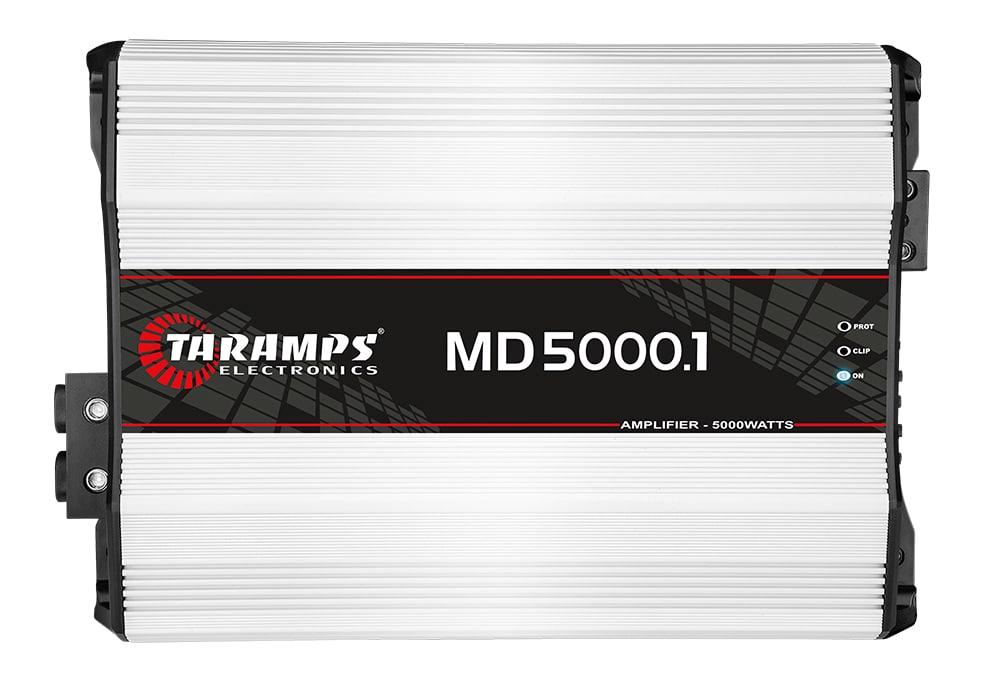

This is the second entry from Taramp in this list because of the wide range of products it produces and their high popularity. With a minimum power requirement of 9 volts, it can pack a loud punch with a 16 VDC output.
Furthermore, at just above 4.5kg, the amplifier is light and easy to carry around. Its thin profile also makes it easy to fit inside a car audio system without any problem.
Pros:
- The amplifier has a high power output of 16 VDC at 1 ohm and 5000 watts.
- It contains the usual set of Taramp’s safety features like low and high power protection, thermal protection, and more.
- This model has a wide frequency range from 10Hz to 10Khz.
- It has an urban look to help it blend in with modern designs.
Cons:
- Most of the Taramp’s models look the same, making them hard to distinguish.
5. Rockville 5000 Watt Peak 2 Channel Power AMP
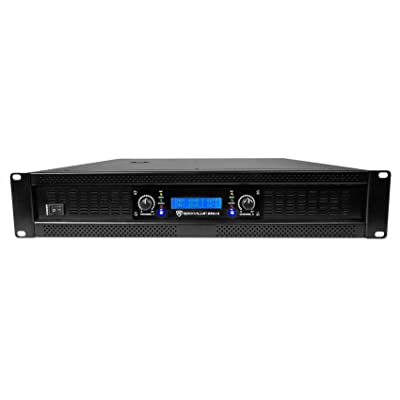

This is the first two-channel amplifier of A/B class in our list. The Rockville 5000 is a heavy-duty amplifier which means business through its design and performance.
It is a two-channel amplifier that can +-+be used in stereo or bridged modes. It also gives you the option to merge the channels for attaching it to a subwoofer.
Furthermore, the LCD and the built-in limiter make sure you have full control over its output.
Pros:
- It has an inbuilt LCD, which shows volume and temperature scales.
- The stereo mode lets you attach four speakers in total in the left and right channels.
- It has built-in LED clipping indicators.
- It has a dedicated crossover switch, which lets you flexibly attach a wide range of speakers.
- Being an A/B class, it provides high-quality sound output.
6. BOSS Audio Systems PD5000 Phantom 5000-Watt Class D Amplifier
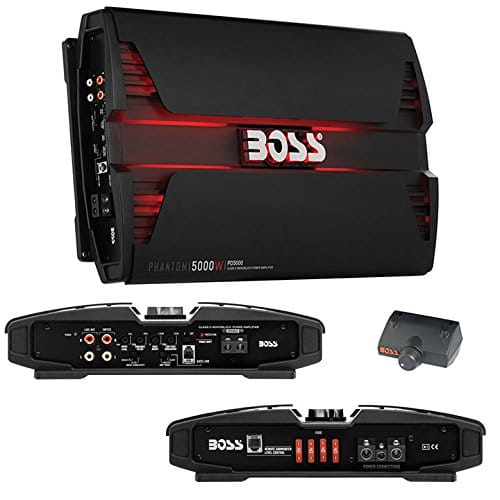

The Phantom from Boss Audio Systems is easily one of our list’s best-looking amplifiers. Lined with customizable LEDs and a bold name, it will look fantastic where ever you keep it!
The amplifier dominates in sound output and its wide range of sound filters, strapping options, MOSFET power supply, and more. It also comes with a wired subwoofer control for that extra precision.
Pros:
- Highly customizable with configurable LEDs, it can fit into any mood.
- It has the option of strapping on another Phantom for double the power.
- The sound filters let you feel the best sound output.
- It has variable input control for anti clipping measures.
- It has an inbuilt phase controller to let you tune the subwoofer sound.
7. Sound Storm Labs EVO 5000 Watt Class D Monoblock Car Amplifier
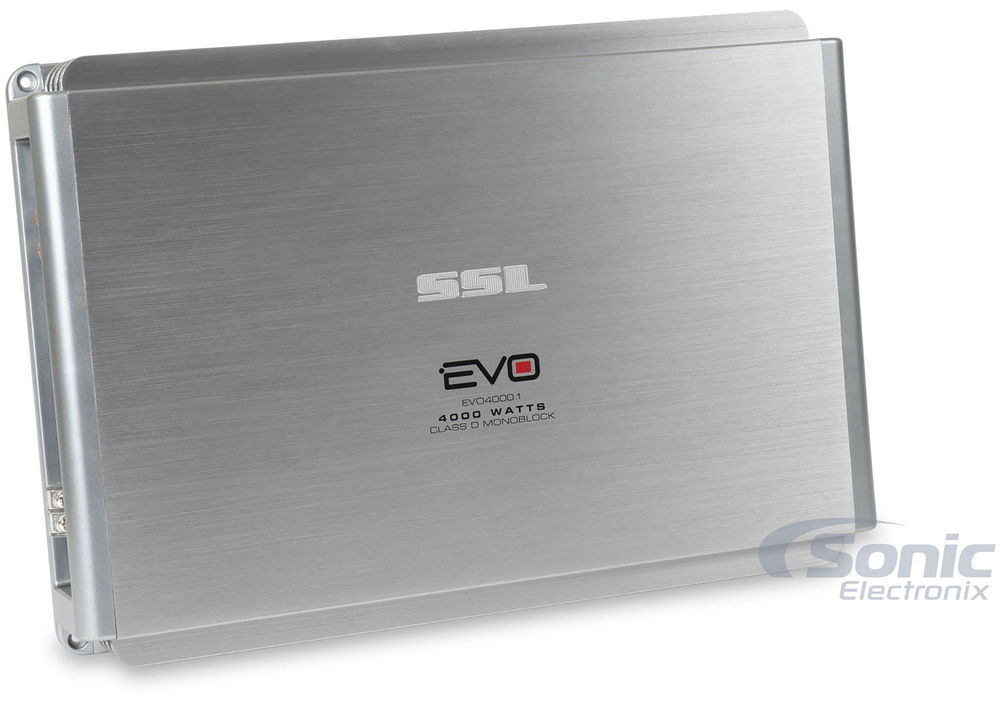

With a MOSFET power input system and a robust bass boost filter, the Evo 5000.1 is all you’ll need to deliver the bass. The RMD of the amplifier is around 3750 watts, but if you need more power, the amplifier lets you strap on another Evo 5000.1 for double the domination!
Furthermore, don’t worry about your speakers’ safety as the amplifier comes with a short protector and phase controlling system.
Pros:
- The amplifier can output 1250 Watts of power at 4 ohms.
- The amplifier comes with a wired subwoofer remote for that precise control.
- For more effortless connectivity, it has an embedded phase control switch.
- It has an included Variable low pass filter, which lets you precisely control the frequencies which go into the amplifier.
- It gives you attached preamp output ports.
8. Taramp’s MD5000.1 2 ohms 5000 Watts Class D Full Range Mono Amplifier
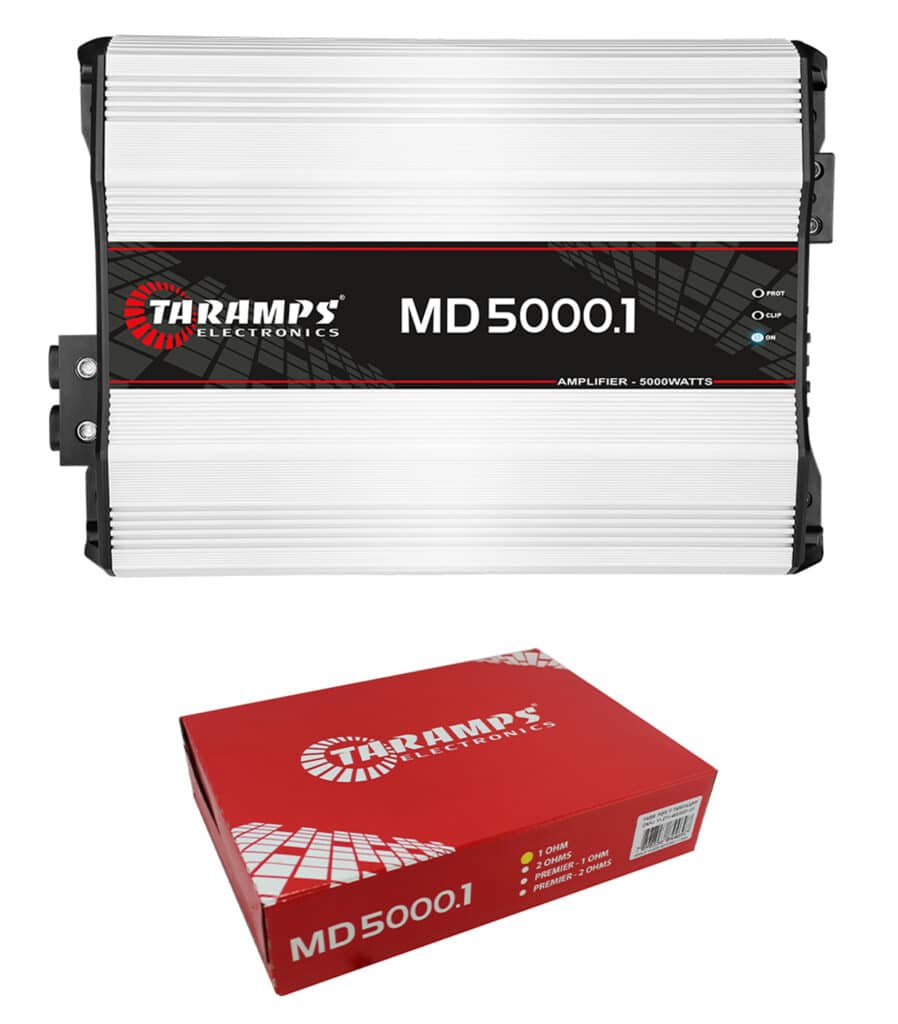

Taramp has something new to offer every time. This time it’s brought the MD 5000.1 2 ohms, which have sleek profiles but packs a considerable punch. It can output a max RMS power of 3200 Watts at 4 ohms.
Furthermore, it has a high tuned low pass and high pass filters, letting you precisely control the inputs and outputs. Even when the amplifier is pushed to its limits, it won’t consume more than 16 VDC of power, making it highly efficient.
Pros:
- It has an efficiency rating of 86%
- The amplifier can operate at a minimum of 9 volts, making it ideal for car setups.
- It has a sleek and lightweight design.
- The amplifier comes with an included bass boost filter for richer bass output.
9. Earthquake Sound 5000W Max, Monoblock Class D Digital Car Amplifier
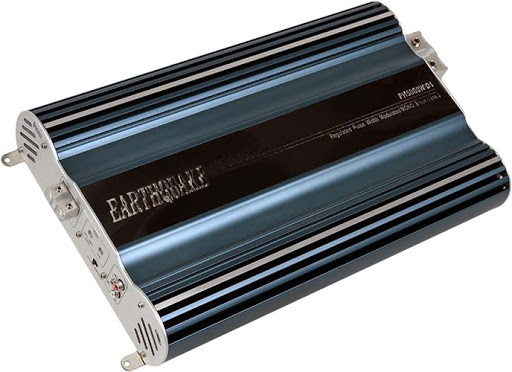

Earthquake sound is one of the oldest audio companies out there. With over 30 years of experience, the PH5000W/D1 amplifier is a product of sheer expertise.
The amplifier has a gorgeous finish along with 2-way protection systems to protect your lovely speakers as well. It also lets you set up bridged and parallel speaker connections for your varying needs!
The speakers also include red indicator LEDs to let you be aware of clipping.
Pros:
- The amplifier is equipped with an aluminum alloy heat sink for better thermal performance.
- The amplifier can operate at a maximum of 4 ohms.
- It has an embedded Soft start speaker protection system.
- This amplifier has input signal sensing capabilities.
- It has the MOSFET power input system for maximum efficiency.
10. Precision Power Class D Mono Amplifier 5000W
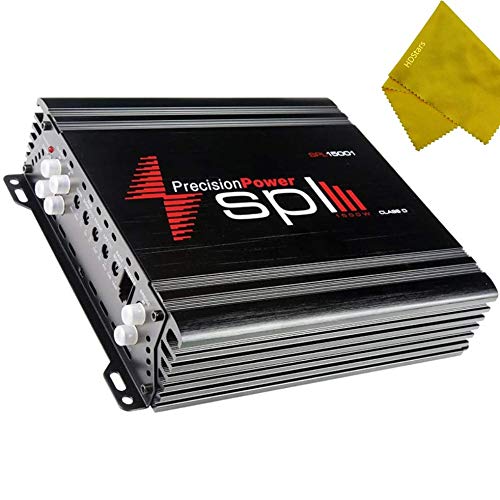

Precision Power is a compact amplifier that can operate in highly flexible scenarios. It can operate at a maximum of 4 ohms delivering 1100 watts of power.
It has inbuilt low-pass and subsonic converters and a bass boost filter for precision control over the output. The amplifier also comes with a remote bass control for controlling the bass efficiently.
Pros:
- It has a compact design for easy transportation.
- It is equipped with sensitive filters for high-quality control over the sound.
- Can operate at high ohms providing ample power.
- It has a sensitive input system numbering at 105dB
- Paired with the bass knob, it becomes highly controllable.
11. Gemini XGA Series XGA 5000 AMPS
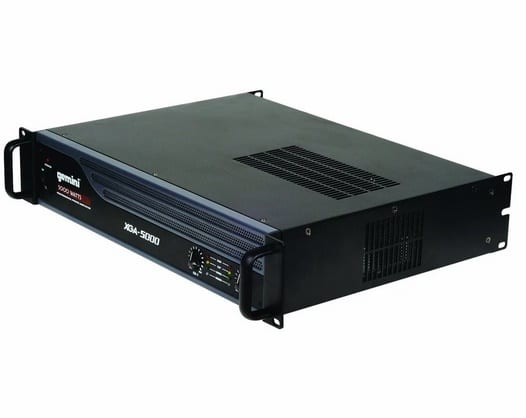

The XGA 5000 is one of the most reliable amplifiers on our list. With high power air cooling system and short/thermal protection systems, the amplifier keeps running no matter what.
It has three output modes, parallel, stereo, and bridge. The harmonic distortion rating of the amplifier is < 0.1%
Pros:
- The amplifier has a professional design that portrays business.
- The frequency sensitivity of the amplifier is in-between 10Hz and 50Khz.
- It has a unique air cooling system backed up by two powerful fans.
- This amp has embedded clipping indicators.
- It is best suited for DJs and their turntables because of its high audio sensitivity.
12. DS18 HOOL-SPL5K1 Compeition Amplifier
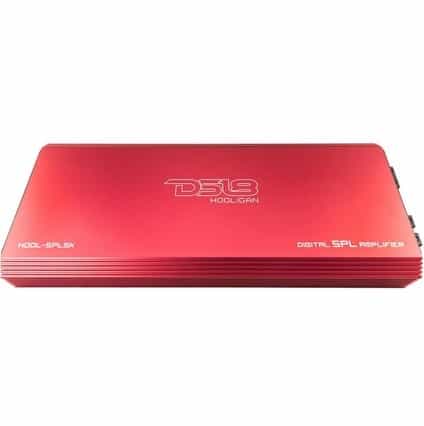

The DS18 HOOL is the most powerful amplifier in this category. It has a maximum output of 7800 watts at its peak. On the other hand, its RMS power is 5000 watts at 1 ohm and 1500 watts at 4 ohms.
It provides you enough headroom for pushing the limits with your music input. Its long and narrow design paired with the eye-catchy red color makes it a fantastic choice.
Pros:
- It has enormous headroom for maximum performance without clipping.
- This amp has an ergonomic design that is both sturdy and functional.
- It has 0-12 dB equivalent bass boot functions.
- The bass knob is included within the amplifier.
Frequently Asked Questions
After going through the reviews and buyers guide, you might have some questions for which you need answers. To clarify everything, here is an FAQ section that should answer most of your questions. Therefore you won’t need to scavenge the internet to find answers to short and straightforward queries!
Do all amplifiers fit into car audio systems?
This feature depends upon the input power requirement of the amplifier. If the power requirement is within 9 to 12 volts, it can efficiently run off a car battery. It is usually because the battery can only supply up to12 volts of power through the car’s circuit.
The class D amplifiers work within this specified range of power requirements. Furthermore, class D amplifiers are also small and compact, making them ideal for a car audio system. There are other classes of amplifiers that might fulfill the requirement, but you need to keep an eye on its specifications for built-in safety fuses and more.
Some car amplifiers require you to attach fuses yourself so that there are little to no chances of damage to the wiring system.
What are the amplifier classes?
There are lots of different classes of amplifiers that correspond to other specifications and features. Usually, class A, B, AB, and D. Class D amplifiers are among the most common and highly produced.
This is because class D amplifiers are small, compact, and efficient. It can be used in various places and produce considerable amounts of power, minimum of 5000 watts.
Class A amplifiers are one of the best amplifiers for sound quality. They are big and chunky in size and therefore are rarely produced. This low production is because class A amplifiers are relatively inefficient and power-hungry.
One of the biggest enemies of amplifiers is heat. Lower the alphabet of the amplifier class higher the operating temperatures. Therefore class D amplifiers run cooler than class A amplifiers.
How to pair speakers with the amplifier?
While pairing speakers with your amplifier, you need to keep an eye on a few things. Doing something wrong here might cause some irreversible damage to your speakers.
First of all, you need to check for your speakers’ impedance rating and match them to your amplifier. The impedance is the electrical resistance of different components within your devices. It is denoted by Ohm.
Usually, your speaker impedance rating should be higher than that of the amplifier. For example, you can attach a 4-ohm amplifier to a 12-ohm speaker.
Secondly, you should watch out for the wattage of the amplifier and your speaker. The wattage rating denotes the output power of the amplifier. There are two types of wattage ratings on amplifiers, RMS or continuous power.
Make sure that the speaker has a higher wattage than the RMS of the amplifier. This is enough to keep the speakers safe and sound.
Lastly, check for the sensitivity rating of the speakers. You should have highly sensitive speakers if you want to buy a low power amplifier. Otherwise, your speakers won’t be loud enough. Furthermore, you need to be up close to your speakers to hear them loudly, which will mean a waste of money.
Do amplifiers improve bass performance?
Yes, amplifiers do improve the bass performance of your speakers. This is especially noticeable with audio systems inside cars. Each audio system and speakers have built-in amplifiers, but they are not that powerful.
In high volumes, you will hear distortion in the bass. Amplifiers filter out the audio signals that reach the speakers and provide a richer and fuller bass output.
Do amplifiers improve sound quality?
While amplifiers are not intended to improve sound quality, they can significantly change how your speakers sound. Usually, speakers have inbuilt amplifiers, but they are of low quality. This distorts the audio signals and makes the speakers sound dull.
On the other hand, external amplifiers have very high-quality filters that feed a richer signal to the speakers, boosting their sound quality.
Is an amplifier necessary for a turntable?
If you are thinking of using vinyl records for your turntables, you will require an external amplifier. This is because the vinyl record cannot produce signals powerful enough for a speaker to recognize.
The amplifier is required to boost the signals and make them recognizable by the speaker.
Is heating inadequate for the amplifier?
Yes, heat is the worst enemy for the amplifiers. It can cause damage to the amplifier in all sorts of different ways. Furthermore, there are a lot of reasons heat is produced in amplifiers as well.
One of the main reasons for amplifiers heating up is a faulty speaker. If a speaker has short-circuited, it might push the amplifier to its limits because it wants to power the speaker.
After that, the second most common reason is improper speaker, amplifier pairing. The rule of thumb is that the amplifier’s impedance should be lower than that of the speaker. If you hook up a high impedance amp to a low impedance speaker, it might create severe heat within the amplifier. Therefore it’ll shut down to save itself.
Lastly, your amplifier might become hot if it is pushed to the limit. This happens when the gain and bass boost settings of the amplifier are not tuned correctly. This might cause the amplifier to reach its peak output power frequently and thereby heat up significantly.
Finally, the class of the speaker can also determine the cause of heating. Class A amplifiers use primitive circuits that produced the best sound but were inefficient when it came to energy transformation. It heats quite a lot because of that fact.
How do amps cool down?
Usually, amplifiers use heat sinks or fans to cool themselves down. Heat sinks are long tubes that run down the sides of the amp. These passively cool down the amplifier by letting outside air absorb the heat.
Other amplifiers actively cool themselves down by using fans to draw in air and blowing them over the components.
Conclusion
Amplifiers have become essential if you’re thinking of setting up a car audio system. They help you get the best bass performance and, along with that, allow your speakers to sound better.
Just go through our buyer’s guide and FAQ section to understand how amplifiers work in general. After that, just choose any one of the amplifiers that have been reviewed!



